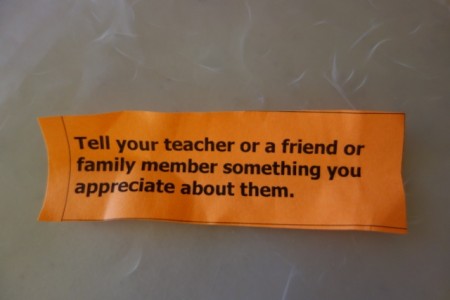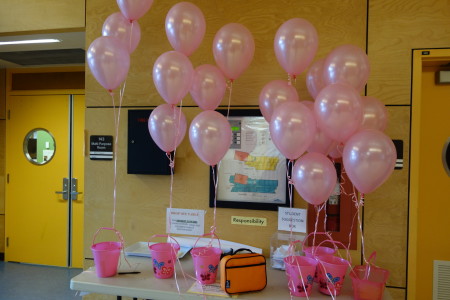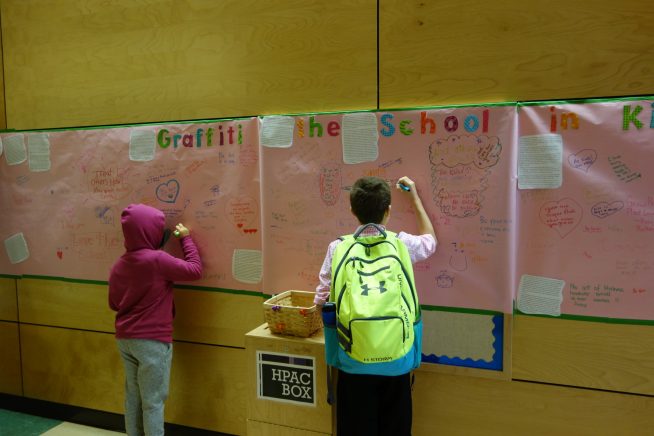Growing Kindness Ideas for an Elementary School
by Carmen G. Farrell, Executive Director, SEEDS www.seedsociety.ca
Most of us parents want our children to fit in, to be happy, and to be “good”. And research* shows that these wants of parents are not only reasonable and complementary, they’re reciprocal. Really?
Yes. Students who regularly perform kind acts can expect to be more accepted by peers and to increase their general sense of well-being. This is important, because while increased social acceptance is also related to positive social and academic outcomes, it also reduces the incidence of bullying.
At one elementary school, parents took on what they called “growing kindness” in a big way. Rather than spend the year on fundraising goals and related activities, the parent group went about actively creating opportunities to “grow kindness” throughout the school! The focus was on regular and purposeful, prosocial activities for students and their families.
 One of the more visible activities was the ways in which special days like “World Kindness Day” (November 13th), “Pink Shirt Day (aka anti-bullying day)” (will be February 24th, 2016), and “Pay It Forward Day” (will be April 28, 2016) were celebrated. Student volunteers cut out brightly coloured “fortunes” of kindness and put them in buckets. Standing outside the school with bright balloons, student kindness ambassadors invited arriving staff, parents and students to draw a fortune at the beginning of the school day. The fortunes said things like: “Say something nice to someone.”, “Thank a teacher, friend or family member for something nice they have done.” or “Help someone at school.”
One of the more visible activities was the ways in which special days like “World Kindness Day” (November 13th), “Pink Shirt Day (aka anti-bullying day)” (will be February 24th, 2016), and “Pay It Forward Day” (will be April 28, 2016) were celebrated. Student volunteers cut out brightly coloured “fortunes” of kindness and put them in buckets. Standing outside the school with bright balloons, student kindness ambassadors invited arriving staff, parents and students to draw a fortune at the beginning of the school day. The fortunes said things like: “Say something nice to someone.”, “Thank a teacher, friend or family member for something nice they have done.” or “Help someone at school.”
After each “day”, buckets of leftover fortunes were placed in each classroom for teachers and students to use as they chose. Some classes took on a “fortune” as a classroom wide initiative and once a month, the class would engage in a random act of kindness…like “Write a kind note and give it to someone”, or “Give a friend or family member a hug.” or “Tell someone they are special.” In other classrooms, kids or staff would help themselves to a fortune when they felt like it and quietly do what the fortune invited them to…like “Give someone a little gift that doesn’t cost anything.”
For the “Pay It Forward” Day, the fortunes had an added component. Participants not only engaged in a random act of kindness, but also invited the person they did something kind for to do the same with another person. The kids really enjoyed this, and the addition of inviting a friend to have the same “kindness” experience turned the act of kindness into a community-building wave of compassion. Kids were sharing things like “Tell a friend or family member something you like about them, then pass this on to them and they can do the same for someone else!” or “Give someone a compliment, then pass this on to them and they can compliment someone else!”…or “Do something kind for someone, then pass this on to them and they can do something kind for someone else!”
For the staff, teacher s and students, the parent group helped create a place where being a school is about fostering compassion by being kind…small acts of kindness go a long way to creating a place where “kindness” is just how it’s done. And for the kids, they realized that demonstrating their caring and thoughtfulness through their actions is not a one-day sort of thing….and that it felt good!
*Layous K, Nelson SK, Oberle E, Schonert-Reichl KA, Lyubomirsky S (2012) “Kindness Counts: Prompting Prosocial Behavior in Preadolescents Boosts Peer Acceptance and Well-Being.”
Lesson Plan: School-Wide Kindness Fortunes
Audience and Outcomes
Appropriate for K-12, but your event(s) will need to include help for primary aged students with reading. This project will encourage children to engage in small, doable random acts of kindness and to experience the social benefits of how these actions impact them and their school community
 Materials and People Required
Materials and People Required
- brightly coloured 8.5 x 11 ” photocopy paper
- computer-generated sheets of kindness fortunes (set up like a page of labels…12 or so per page)
- buckets to hold the fortunes. For a school of 400, plan on 8-10 buckets
- brightly coloured helium-filled balloons to tie to the buckets to attract attention
- one or two people to lead the event with 4 or 5 parent volunteers
- team of intermediate-grade level student volunteers(old enough to be good readers to help younger students) to hand out fortunes
- optional painted, decorated banner advertising your “special day” outside at the front of the school
- several pairs of scissors (kids can cut out fortunes at a meeting) or access to the school cutter to snip many fortunes at once
Event(s) Planning
- with school administration’s support (implicit or explicit), assemble parent volunteers and identify areas of interest
- invite student involvement…could be student council, school-wide, starting a kindness club
- meet with students to plan and activate their thinking about what kindness, compassion and empathy are by inviting them to explore ideas through video, discussion and their own research.
- Some kindness fortune ideas can be found at: https://www.randomactsofkindness.org.
- To see how one school approached random acts of kindness, show upper intermediate and secondary-aged students, “The Breakfast Club” (https://www.youtube.com/watch?v=wfsPdFNQA10)
- For the concept of “Pay it Forward”, students of all ages would enjoy “Pay it Forward-Inspirational Video” (https://www.youtube.com/watch?v=GJeWFoKZ63U)
- For messages about what being kind to others can do for YOU, show students videos like “Club G” (https://www.youtube.com/watch?v=9FwuMHnR9BU) for intermediate students.
- make sure to include all staff…this is where the school administrator could be very helpful
On Your “Kindness Fortune” Day
- check the weather…remind kids to dress so they will be comfortable
- ask volunteers to arrive early enough to organize the balloons
- try to have at least two students per bucket so that one can be helping the younger students if needed
- position volunteers in the high traffic areas as people arrive at school and wish “customers” a Happy [whatever day you are celebrating]!
- don’t forget to offer fortunes to all school staff
Follow-Up Activities
- in classrooms, invite kids to talk about what they did for their random acts, how they felt about it, and what did they notice about how people responded to them?
- place one bucket of leftover fortunes in each class and invite teachers and students to continue to engage in random acts of kindness
- follow-up with the student and parent volunteers and “debrief” the event. Ask yourselves things like: how could we build upon this? what worked especially well?
- ask classes to write up some of their best experiences and share them with the school via the parent newsletter, school newsletter, front hall school display, or school-wide assembly (or parent volunteers interview the classroom teachers and write it up for them)
- read books during story time about kindness (primary), choose kindness-related books for literature circles in higher grades
